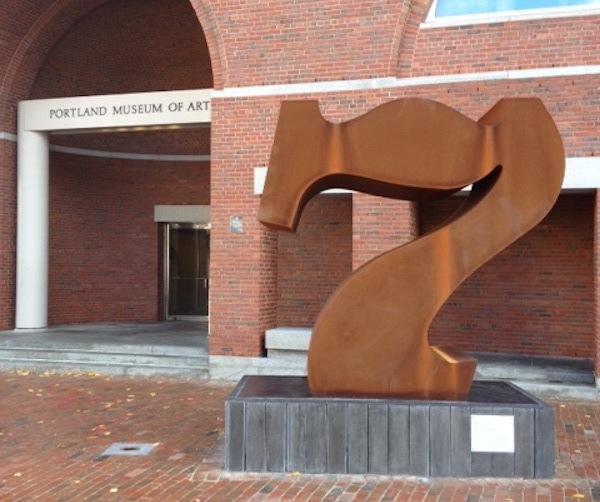Visual Arts Feature: When a SEVEN Is More Than a Seven
Most museums today dream of coming up with striking images that energize their members and engage the public. In that sense, the Portland Museum of Art’s acquisition of SEVEN combines a significant artistic statement with a marketing coup.

Robert Indiana’s SEVEN now sits in front of the Portland Museum of Art. Photo: Kristen Levesque.
By Kathleen C. Stone
The Portland Museum of Art has installed SEVEN, a sculpture by Robert Indiana, outside its front door. The piece signals that the museum has a significant collection: not just high rollers but anyone who ventures inside will no doubt be lucky — when it comes to finding aesthetic experiences.
The sculpture was unveiled on the evening of November 7 at an outdoor ceremony that featured colored lights dancing over the sculpture’s steel surface, remarks by museum staff, and a cappella singing by Bowdoin College students, all in cold winds gusting to thirty. But the winds did nothing to detract from the sense of fun, or deter onlookers, out for the city’s First Friday art walk, who crowded around the sculpture.
Fun is not the only way to look at the sculpture, but it is a place to start. SEVEN is a stylized digit in the exaggerated font first used by Indiana in the 1960s, when he was beginning to incorporate numbers and short words into painting. Pop art was in its ascendancy and Indiana, then living among other artists in lower Manhattan, was a major figure in the movement. Two decades later, still infusing numerals with graphic form and color, Indiana created a series of oversized digits, one through zero, in polychrome aluminum; those pieces are now owned by the Indianapolis Museum of Art. In 2003, he commissioned a foundry to execute the number series in Cor-Ten steel, and the Portland Museum’s Seven was born.
The sculpture’s form is curvaceous, almost sensual, with the numeral’s horizontal bar cantilevered over the angled base. The Cor-Ten surface appears velvety, seeming to invite you to curl up comfortably alongside. (But you shouldn’t — Cor-Ten, designed to endure the weather, is sensitive to human touch.) One’s first impression is the whimsical nature of the piece and the wit underlying the museum’ decision to place this giant numerical figure outside its door.

SEVEN decorated with colored lights. Photo: Kristen Levesque.
But SEVEN is more than an act of wit. Indiana has appropriated something we see every day, an Arabic numeral, and made art out of it, an object with shape, color, presence, and its own levels of significance. While SEVEN spells out the museum’s location (7 Congress Square), it also invites reflection on how and why we endowed a figure (essentially a fifty degree angle) with the power to mean anything at all.
Before the unveiling, I had a chance to sit down with chief curator Jessica May. “We are experiencing an Indiana moment,” she insisted. “Last year’s retrospective at the Whitney Museum reinserted Robert Indiana into the story of Pop Art in a serious, substantial way.” The Whitney show Robert Indiana: Beyond Love, explored the artist’s work before and after his well-known arrangement of letters (L-O-V-E), whose’ Summer of Love’ resonances have unfairly overshadowed his career. The Portland Museum has other Indiana work — two paintings, various prints, a textile piece and, on long term loan from the artist, an early sculpture. SEVEN complements its holdings in a significant way.
Most museums today dream of coming up with striking images that energize their members and engage the public. In that sense, the Portland Museum’s acquisition of SEVEN is a coup. It has created an instant landmark, an icon for the city and the institution. Years ago, director Mark Bessire saw the piece installed in another location and knew he wanted it for Portland; the fact that Indiana lives in Maine, on the island of Vinalhaven, almost gave his quest a sense of inevitability. Over one hundred donors, including a cadre of museum members under the age of forty, made it happen.
As for engaging the public, I offer this anecdote. At the unveiling, I was standing next to the sculpture when two girls, probably high school age, approached me. “What’s this supposed to be?” they asked. I said something about how the artist had taken something simple and made it complicated and personal; in other words, he had made art. “That’s really cool,” they said, and walked over to get a better view.
Kathleen C. Stone is a writer pursuing her MFA degree, a lawyer who earned her JD many years ago, and, even before that, was a student of art history. Her blog can be found here.
